Narrelle M. Harris's Blog, page 29
October 31, 2017
New Release: Sherlock Holmes: The Australian Casebook
 Today is the launch day for Sherlock Holmes: The Australian Casebook – an anthology of Sherlock Holmes stories set in different parts of Australia in 1890.
Today is the launch day for Sherlock Holmes: The Australian Casebook – an anthology of Sherlock Holmes stories set in different parts of Australia in 1890.
I was delighted to have an opportunity to write another Holmes story set in Colonial-era Victoria after my Holmes/Watson 1893 romance, The Adventure of the Colonial Boy, and promptly set about using my goldfields research in a more traditional Holmes+Watson tale.
Bonnier Publishing’s blurb on the fully illustrated anthology says:
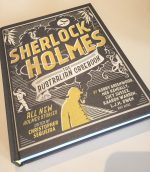 It’s 1890. Holmes’s fame has spread even to the colonies, and he and his stalwart chronicler Watson are swept up in an array of mysteries Down Under. They find themselves summoned from place to place, dealing with exciting and unique mysteries in every corner of this strange island continent.
It’s 1890. Holmes’s fame has spread even to the colonies, and he and his stalwart chronicler Watson are swept up in an array of mysteries Down Under. They find themselves summoned from place to place, dealing with exciting and unique mysteries in every corner of this strange island continent.
My story, “The Mystery of the Miner’s Wife”, begins with Watson in a grumpy mood in a Melbourne coffee palace , but soon Sherlock Holmes and his Boswell are catching the train to Ballarat to solve a peculiar murder. Here’s an extract:
The sergeant’s weary eye lighted first on me, and after an uninterested sniff, on Holmes. He sniffed again. “This is a London detective, is it?” asked the surly fellow. “He doesn’t look much. I’d bet we’ve got detectives twice as good even here in Ballarat, let alone Melbourne or Sydney.”
Holmes’s fine lips quirked in a swiftly suppressed grin. “A betting man, are you?” he challenged in good humour, “What about a wager, then. I’ll tell you a secret about yourself and if I’m right, you’ll fetch Detective Meredith for us. Does that sound fair, Sergeant-?”
“Clark,” smirked the sergeant, “And if you’re wrong?”
“A sovereign, and the boast that you have bested the London detective, Sherlock Holmes.”
My story has a marvellous illustration by Jan Scherpenhuizen, one of three people providing gorgeous images, a la The Strand Magazine, for the anthology. The other two artists are Philip Cornell and Marcelo Baez.
I’m so proud to be in the company of my fellow Holmesian writers: Kerry Greenwood and Lindy Cameron, Meg Keneally, Kaaron Warren, Lucy Sussex, L.J.M. Owen, T.S.P. Sweeney, Jan Scherpenhuizen, Will Schaefer, Robert Veld, Doug Elliott, Philip Cornell, Raymond Gates, Jason Franks, Steve Cameron, and Christopher Sequeira (who also edited the book). Baker Street Irregular Bill Barnes provides the introduction.
Sherlock Holmes: The Australian Casebook is now available:
Hardcover
Sherlock Holmes: The Australian Casebook (Booktopia)
Sherlock Holmes: The Australian Casebook (Angus and Robertson)
Sherlock Holmes: The Australian Casebook (Five Mile)
Kindle
Sherlock Holmes: The Australian Casebook (Amazon Australia)
Sherlock Holmes The Australian Casebook [image error] (Amazon US)
Or you can check Echo Publishing for more details.
October 17, 2017
Interview: Tansy Rayner Roberts and Belladonna University
 My longtime readers know that I’ve loved Tansy Rayner Roberts’ work for years, from her Creature Court series through to the crime cosies set in Hobart that she writes as Livia Day and the delightful Castle Charming series. When I discovered she had a Patreon account, I rushed on in to pay $3 a month to read new work as it arrives!
My longtime readers know that I’ve loved Tansy Rayner Roberts’ work for years, from her Creature Court series through to the crime cosies set in Hobart that she writes as Livia Day and the delightful Castle Charming series. When I discovered she had a Patreon account, I rushed on in to pay $3 a month to read new work as it arrives!
The latest of her series that has won my heart is set at a magical university. Fake Geek Girl was the first, and with The Bromancers (the fourth in the sequence) now out, I asked Tansy to tell me more about writing these lovely books.
Tansy Rayner Roberts
How do you describe the Belladonna University series?
Belladonna University is a series of fun novellas about the everyday lives and loves of a bunch of Aussie student witches and their rock band Fake Geek Girl.
You have four novellas out in the Belladonna University series, starting with Fake Geek Girl, then Unmagical Boy Story, then you prequelled those with The Alchemy of Fine – and now The Bromancers is out. The stories are sharp, funny and full of heart, and play with a lot of ‘magic school’ tropes while being utterly fresh and modern. What were your influences in creating Belladonna U?
I first started thinking about it when visiting Melbourne – the idea of a uni sharehouse full of witches, in a square full of hipster coffee places and slightly skeevy pubs. So many influences.
Eainbow Rowell’s Fangirl made me think a lot about fandom and how fannish people relate to the world. I wanted to write about people who lived in a supernatural world, and what THEIR fandoms would be like. I was also inspired by fannish musicians, having been a big follower of trock back in the day (ahh Chameleon Circuit). The geeky sister act The Doubleclicks and the way they write and perform about big, important contemporary issues through a fannish lens was hugely influential. And of course there’s Harry Potter and the age-old fanfic trope that asks the question what WOULD wizards do about university?
 What are your basic rules about how magic works in this world?
What are your basic rules about how magic works in this world?
I don’t have a simple answer to this. The majority of people have some form of magic and identify as witches, probably around 70% of the population? But everyone has their own relationship with it. Certainly high magic is associated with both wealth and privilege. Magic is always presumed to be the default.
But we have families with different approaches – the Hallows are very hippie-dippie old school hedgewitches with strong practical magic running through their line. The Chauvelins, Vales and Nightshades are far more about your fancy, advanced high-status sorcery. Then we have families like the one that Sage came from, who exist in isolationist anti-magic communities.
One rule is that technology and magic don’t mix – often with explosive and messy results, but it’s not always that predictable. Another is that caffeine has quite a powerful numbing/dampening effect on personal magic, which means some very different social rituals for our uni students, but also many of them will use it deliberately. Strong magic in two people in physical proximity can be complementary or quite destructive. (yes, this affects their sex lives) I’m feeling my way through this!
The characters all come across as very real as well as very contemporary. Have you drawn on experiences or people you know to get that very modern sense of characters?
Not really? Which is to say, yes, probably. But they’ve all been in my head so long, I think of them as being themselves rather than being based on specific people. There’s a lot of my uni years jammed in there, and people I knew in my early 20s, though I didn’t experience a lot of the traditional uni student “tropes” myself – so there’s a lot of imagination in there too!
Do you identify more closely with one of the characters? (I won’t ask your favourite – I can’t even pick one myself – though if you have a favourite, do share!)
Hebe and Sage are probably the easiest to write, not least because the stories so often revolve around them. Hebe reminds me a lot of myself at 19 in some ways, though not at all in others. Sage isn’t like me at all, but he looms so large in my head! I have no idea where he came from. Viola is a lot like me too, in some ways – though she’s a lot more ambitious! I have fond memories of my postgrad years and I like her intellectual side very much, even though there is VERY LITTLE UNI WORK that gets done in these stories. Juniper is uncomfortable for me to write because she’s a little too close to the bone for me – again, in some ways, not at all in others.
Basically the characters who are the most active protagonists are probably my favourites, but that’s a vicious cycle. I’m getting fonder and fonder of Holly, especially since The Alchemy of Fine where I started letting myself see the world through her eyes a bit.
The stories speak very positively about fans, fandom and fanfic (well, with one very big caveat in the latest). What has been your experience of fandoms?
I see the world through fannish eyes. My experience of fandoms as such as been very mixed – lots of positives, lots of negatives, but they are worlds I understand. I met some of my closest friends online through fannish or fan-adjacent activities. I’m raising kids via media criticism.
So yes on the whole I think of fannishness as something lovely, though there’s always that slightly darker edge to it that I did bring in with the most recent story – fan entitlement and possessiveness (and developing hatred/anger towards the creator) can be very uncomfortable at times, and there are fandoms I have removed myself from because of that overwhelming negativity.
Are you planning any novel-length adventures for the band?
I don’t want to because I am so over novels, but it’s probably inevitable. I have a Ferd/Chauv scene in my head that feels like the start of a novel. Damn it.
Are any of the songs actually being recorded anywhere?
Nope nope nope!
Either way, how do you feel about the idea of readers with musical talent writing music and performing the songs?
Aww that would be so lovely, but it’s a world I know nothing about. I’m horribly unmusical. Writing the songs that I have was confronting enough! (and I feel I need to write more but it’s so HARD, writing about songs is easier)
The stories are released first to your Patreon supporters, usually after you’ve podficced them. What do you enjoy most about creating Belladonna U as podfics?
The freedom and indulgence to write whatever I want. My readers like them. I don’t have to think about pleasing an imaginary audience out there – I have a nice cosy one right here. I don’t think about whether my stories are Important or Meaningful, I write them purely to entertain myself. Having said that, I do think they are quite meaningful, to me at least.
 How have you found the Patreon experience overall?
How have you found the Patreon experience overall?
I love Patreon. I first used it to fund the writing of a serial novel, Musketeer Space, and once that project wound up I put a lot of thought into how to create an ongoing project that was sustainable.
Some authors put out a short story a month, but I couldn’t keep up that pace, and I particularly wanted to write more stories that were at the novelette/novella length, following the same characters across multiple stories. Those kinds of stories are difficult to sell to magazines etc because of the length and because of being sequels. Fake Geek Girl was actually one of the stories that gave me this idea – to create and publish via podcast and also through the Patreon itself, building an audience who want to read more stories that are completely TANSY.
I can’t manage a whole story every month, but I can manage a new instalment of a novella/novelette every week – and the best thing is that having the waiting audience gets me writing, even when there aren’t other publisher deadlines on the horizon.
I can also use it to reprint stories that have appeared elsewhere, giving them new life and helping them find a wider audience. I’m really happy with how it’s going — though of course it would be a lot more sustainable if I had twice the number of patrons! Still, I just hit 100 which is a marvellous milestone.
The Alchemy of Fine is exclusively available via Tansy’s Patreon. Fake Geek Girl is available as a free download if you sign up to Tansy’s newsletter.
Get Fake Geek Girl (and Glass Slipper Scandal!) from Instafreebie.
Support Tansy Rayner Roberts’ Patreon (and get access to podcasts of her stories and new short works as they become available!)
Unmagical Boy Story & The Bromancers are available from ebook stores everywhere, though Patreon supporters can download them as part of their membership perks.
Belladonna U on Amazon.com
Unmagical Boy Story (Belladonna University Book 2)[image error]
The Bromancers (Belladonna University Book 3)[image error]

October 11, 2017
Review: A Case of Domestic Pilfering by Rohase Piercy with Charlie Raven
 Being known as someone who enjoys multiple interpretations of Sherlock Holmes and John Watson has its rewards. I was contacted out of the blue a few months ago with an offer of a review copy of A Case of Domestic Pilfering, a story originally written by Charlie Raven and then reworked by Rohase Piercy.
Being known as someone who enjoys multiple interpretations of Sherlock Holmes and John Watson has its rewards. I was contacted out of the blue a few months ago with an offer of a review copy of A Case of Domestic Pilfering, a story originally written by Charlie Raven and then reworked by Rohase Piercy.
I haven’t read any of Piercy’s other fiction yet, but I know her 1988 book, My Dearest Holmes, is a queer reading of the relationship, so I thought there might be a certain sympatico.
A Case of Domestic Pilfering is a delightfully fast-paced adventure seen mainly through the eyes of well-to-do Guy Clements and his dear friend Max Fareham in the summer of 1890.
They are very much more than good friends, in fact, and not always as discrete as they might be. Guy is vivacious and more than a little foolish, an extroverted drama queen and aesthete, more Bosie than he is Wilde, despite his pretentions. Max is less well off, less overt, and really very sweet.
They fall into trouble through a combination of events, including the theft of some important documents, a clever and desperate young housemaid, a shortfall of funds for gambling debts, a little domestic pilfering, and a chance meeting with Dr John Watson at the races.
Holmes of course is involved in an investigation and all the elements become rather tumbled as the Great Detective doesn’t quite get hold of the right end of it.
Holmes and Watson are supporting characters in a story of misunderstandings, cross-purposes, disguises and secrets. It feels very much Wilde meets Wodehouse, with it’s foppish upper class young men who are mentally negligible.
The book is hugely fun and reads at a smart pace. I’ll definitely be looking for more of Piercy’s work -.
You can read an excerpt of A Case of Domestic Pilfering here.
Buy A Case of Domestic Pilfering
A Case Of Domestic Pilfering [image error] (Amazon.com)
A Case of Domestic Pilfering (Amazon UK)
A Case of Domestic Pilfering (Amazon Australia)
A Case of Domestic Pilfering (Bookdepository)
A Case of Domestic Pilfering (Wordery)
September 20, 2017
The Lady Novelist follows a Roman Road
 Londinium. Roman Baths. All roads lead, etc. I’ve been in various parts of the former Roman Empire, from Hungary, Egypt and Jordan to Rome itself.
Londinium. Roman Baths. All roads lead, etc. I’ve been in various parts of the former Roman Empire, from Hungary, Egypt and Jordan to Rome itself.
It’s always fun to find little bits of older civilisations in layers under the current one. It’s like etymology for landscapes – the backstories that help to describe, to a degree, how the current narrative unfurled.
Londinium
 This trip, besides burrowing into Sherlock Holmes and Richard III, Tim and I have been poking about the remains of Roman Britain. In London we went on a self-guided Roman London walk and visited the remains of a Roman bath house located under an office building at Billingsgate.
This trip, besides burrowing into Sherlock Holmes and Richard III, Tim and I have been poking about the remains of Roman Britain. In London we went on a self-guided Roman London walk and visited the remains of a Roman bath house located under an office building at Billingsgate.
 The guide was brilliant at bringing stones and dirt to life, describing the uses of the larger buildings that once stood here, and the remaining chambers, and drawing parallels with modern life (dodgy builders, cost-cutting measures, lovers’ trysts, unsolved mysteries).
The guide was brilliant at bringing stones and dirt to life, describing the uses of the larger buildings that once stood here, and the remaining chambers, and drawing parallels with modern life (dodgy builders, cost-cutting measures, lovers’ trysts, unsolved mysteries).
Very much worth the visit!
Hadrian’s Wall
 Of course, the Romans inhabited Britain for several hundred years, from the southern end right up to the Antonine Wall, north of the more famous Hadrian’s Wall, built in AD122.
Of course, the Romans inhabited Britain for several hundred years, from the southern end right up to the Antonine Wall, north of the more famous Hadrian’s Wall, built in AD122.
Which, not coincidentally, is the number of the bus that runs in a circuit between Hexham and Haltwhistle, enabling those short on time or the inclination to hike to visit key sites along the remains of Hadrian’s Wall.
 Our first stop was Chester’s Fort, which predates the wall, then boarded the bus again for Housesteads. The remains of a Roman fort are here too and, key for us, a large segment of the wall.
Our first stop was Chester’s Fort, which predates the wall, then boarded the bus again for Housesteads. The remains of a Roman fort are here too and, key for us, a large segment of the wall.
Tim had done a little googling. A walk between Housesteads and the next stop, Steel Rigg, should take about an hour and a quarter, claimed Google, giving us a topography map and a false sense of confidence. It’s only 4.6km, said Google slyly. It’s a sunny day. Go on. Walk a bit of the wall.
 Off we went, wreathed in sunshine, the wall on our right, a song in our hearts. We were striding hilltops where nearly 1900 years ago, men from across Rome’s vast empire piled up stones to mark the extent of their Empire’s territory.
Off we went, wreathed in sunshine, the wall on our right, a song in our hearts. We were striding hilltops where nearly 1900 years ago, men from across Rome’s vast empire piled up stones to mark the extent of their Empire’s territory.
They served as citizens, or in the hope of becoming citizens. They maintained the border, defended it as required. They waited for letters from home, looking out over green hillsides and the vistas of all that weather rolling in, clouds gathering and parting, looming and clearing.
Black-faced sheep eyes us warily; very large cows were more sanguine. Energetic people with hikin g poles passed us in either direction, cheerily saying it was hours to go until Steel Rigg, and with much rougher and muddier terrain.
g poles passed us in either direction, cheerily saying it was hours to go until Steel Rigg, and with much rougher and muddier terrain.
We would have thanked them, but we were too busy negotiating steep rises and falls and trying not to face-plant among the rocks.
 Finally, two hours into our one hour walk and still only half way to our destination, we came to a little farm, with a lovely little road leading right back out to that wonderful main road that had buses on it. We decided it had been fabulous. Beautiful and breathtaking and thoroughly worthwhile to have walked those hills alongside that amazing wall.
Finally, two hours into our one hour walk and still only half way to our destination, we came to a little farm, with a lovely little road leading right back out to that wonderful main road that had buses on it. We decided it had been fabulous. Beautiful and breathtaking and thoroughly worthwhile to have walked those hills alongside that amazing wall.
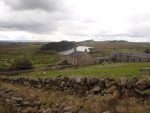
Then we went straight on down that farm road and caught a bus to the next stop. Sandwich and soup in the brand-spanking-new centre at The Sill fuelled us for a final bus ride to Vindolanda.
 Only the preceding week, the news had announced that digs at Vindolanda had located a cavalry sword – a rare find, since such weapons were very valuable – and the brass fittings of riding harness. And not quite a month after being dug up from the site, these pieces were on display at the Vindolanda museum.
Only the preceding week, the news had announced that digs at Vindolanda had located a cavalry sword – a rare find, since such weapons were very valuable – and the brass fittings of riding harness. And not quite a month after being dug up from the site, these pieces were on display at the Vindolanda museum.
Weary with our triumphs, we got the bus back to Hexham – transported by AD122 back to 2017 and the joys of a hot meal at a Hexham pub and a hot shower at our B&B.
 On the morrow, the AD122 took us to a brief stopover at the Roman Army Museum, which makes brilliant use of audio visual and a little 3D movie to bring the people of the Roman Empire to life. In the process, all those stones along which we tramped, all those walls razed to a few feet high, were depicted evocatively as the lonely outposts, for these soldiers far from home.
On the morrow, the AD122 took us to a brief stopover at the Roman Army Museum, which makes brilliant use of audio visual and a little 3D movie to bring the people of the Roman Empire to life. In the process, all those stones along which we tramped, all those walls razed to a few feet high, were depicted evocatively as the lonely outposts, for these soldiers far from home.
Carlisle
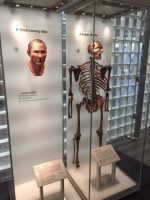 From AD122 to Haltwhistle and thence to Carlisle, where the Tallie House Museum gives up a little more of the region’s Roman history – including a murder mystery! The body of a man found dumped in a well was doubtless done in by foul play.
From AD122 to Haltwhistle and thence to Carlisle, where the Tallie House Museum gives up a little more of the region’s Roman history – including a murder mystery! The body of a man found dumped in a well was doubtless done in by foul play.
I’m sure Richard III would empathise, even if Sherlock Holmes is unlikely to ever solve it.
Tim and I visited all these museums thanks to Visit Britain; accommodation in Carlisle was courtesy Accor Hotels.
All roads lead to Rome, and also to my most recent fiction.
lead to Rome, and also to my most recent fiction.
Ravenfall , a paranormal thriller and gay romance set in contemporary London,
Near Miss , a short lesbian love story with yarnbombing, set in Melbourne.
If het love/adventure stories are more your thing, check out my spy series, Secret Agents, Secret Lives .
September 17, 2017
The Lady Novelist pays her respects to King Richard III (part 2)
 After a day exploring the Bosworth Battlefield Heritage Centre (and regretting that I’d missed the annual re-enactments of the battle in August) I rested my weary head in the splendid Richard III room at the Belmont Hotel.
After a day exploring the Bosworth Battlefield Heritage Centre (and regretting that I’d missed the annual re-enactments of the battle in August) I rested my weary head in the splendid Richard III room at the Belmont Hotel.
My possibly misplaced fondness for dear old Richard meant that I slept peacefully under the watchful eye of his portrait instead of wondering when he might instructing his minions to “rumour it abroad that Narrelle, my fanciful biographer, is sick and like to die”.
And then I went into Leicester in search of the real Richard III
King Richard III Visitor Centre
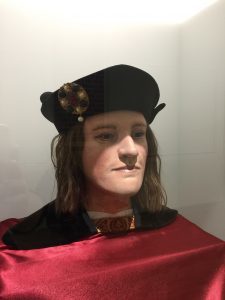 My first port of call was the King Richard III Visitor Centre. Its subtitle ‘Dynasty Death and Discovery’ is an excellent precis of what you’ll find within.
My first port of call was the King Richard III Visitor Centre. Its subtitle ‘Dynasty Death and Discovery’ is an excellent precis of what you’ll find within.
Temporary displays and an excellent audio-visual presentation give a good overview of the dynastic ructions which preceded Richard’s claiming of the throne from his brother’s boy Edward V, on the basis that Edward IV’s children were illegitimate.
(There is apparently evidence that Edward V, a known philanderer, had actually been married before he married Elizabeth Woodville, and that his first wife was still alive and in a nunnery. Parliament agreed with Richard and proclaimed the boys bastards.)
Understanding all this dynastic and even tribal argy bargy between the Yorks and the Lancasters is a bit of an ask, but vital to understanding what happened to bring Richard III to the throne and shortly thereafter to an ignominious burial. The KRIII centre does a good job of this before leading the visitor through displays that precis the key points of Richard’s reign and on to the challenges to his rule, the still unexplained disappearance of his disinherited nephews, and the final battle at Bosworth Field.
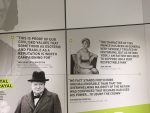 Upstairs, the displays look more at the popular opinion of Richard as influenced both by Shakespeare and the organisations, existing since the 19th century, which aimed to give a more balanced and realistic account of the man and his rule.
Upstairs, the displays look more at the popular opinion of Richard as influenced both by Shakespeare and the organisations, existing since the 19th century, which aimed to give a more balanced and realistic account of the man and his rule.
From there to the forensic account of the discovery of his body by members of the Ricardians, how his bones were identified and what was learned from his body.
The replica of his bones with material on the various wounds he received at Bosworth was what moved me the most. Accounts say he swore to live and die a King and not retreat from the field, and the blows he received, including an insulting post-death stabbing, seem to speak of courage, desperation and cruelty, all.
Leicester Cathedral tour
 That curious sorrow for a long dead king struck me again when Tim and I went next to Leicester Cathedral, where we were guided around the church, as it was back in the day. Our guide spoke of the thousands who came to pay their respects to the lost king’s remains – spurred by curiosity as much as compassion, one supposes. The guide spoke in wonder of a woman who flew out from Moscow a day after seeing the thousands of people who lined up to see his coffin and its sumptuous funeral pall.
That curious sorrow for a long dead king struck me again when Tim and I went next to Leicester Cathedral, where we were guided around the church, as it was back in the day. Our guide spoke of the thousands who came to pay their respects to the lost king’s remains – spurred by curiosity as much as compassion, one supposes. The guide spoke in wonder of a woman who flew out from Moscow a day after seeing the thousands of people who lined up to see his coffin and its sumptuous funeral pall.
The simple alabaster tomb over his grave is elegantly carved and angled. “On the six sunny days we get in Leicester,” said our guide, “The sun comes through the stained glass window to reflect colours on his grave.”
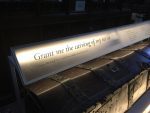 The idea of that made me happy in a melancholy way. Richard’s body was bundled, naked, from the battlefield on the back of a horse. He was stabbed, post-mortem, and put on display to prove he was dead. He was buried hurriedly in a nearby Friary, so not completely without respect, but his head was bent, his hands were tied. His bones seemed small and sad in the pictures where they were found in situ. This simple, solemn, elegant grave feels like a kindness.
The idea of that made me happy in a melancholy way. Richard’s body was bundled, naked, from the battlefield on the back of a horse. He was stabbed, post-mortem, and put on display to prove he was dead. He was buried hurriedly in a nearby Friary, so not completely without respect, but his head was bent, his hands were tied. His bones seemed small and sad in the pictures where they were found in situ. This simple, solemn, elegant grave feels like a kindness.
Although that Catholic and devout gentleman would no doubt spin in his elegant grave at thought of what that wicked Shakespearean version of him gets up to with Khan in my stories, I’m glad to see at last a more balanced and just view of his achievements and flaws, and the great shadow cast over both by those two lost boys.
Leicester and King Richard III Walking tour
Richard and I aren’t done with each other quite yet though. Our last Ricardian treat is the Blue Badge walking tour with our guide, Steve.
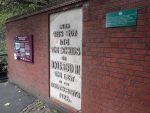 The walking tour shows other parts of Leicester’s history – it’s not all dead kings and surprise wins by the local football club. There are Roman ruins too. Richard’s history is also replete with mistaken historians and uncertainties about what really happened. Until relatively recently, Richard’s remains were thought to have been dug up and thrown into the river under the Bow Bridge. Near the bridge in question, three separate plaques refer to the changing understanding of that incorrect history.
The walking tour shows other parts of Leicester’s history – it’s not all dead kings and surprise wins by the local football club. There are Roman ruins too. Richard’s history is also replete with mistaken historians and uncertainties about what really happened. Until relatively recently, Richard’s remains were thought to have been dug up and thrown into the river under the Bow Bridge. Near the bridge in question, three separate plaques refer to the changing understanding of that incorrect history.
 Steve’s tour gives a broader view of Leicester and elements of Richard’s story in the landscape where it took place. For all his wicked reputation, Richard is still viewed with some pride by the locals and streets are named for him as well as numerous pubs. People place white roses at the feet of his statue.
Steve’s tour gives a broader view of Leicester and elements of Richard’s story in the landscape where it took place. For all his wicked reputation, Richard is still viewed with some pride by the locals and streets are named for him as well as numerous pubs. People place white roses at the feet of his statue.
 Grant me the carving of my name says the beautiful poem by Carol Ann Duffy, which was read at his reinterrment. Richard has been granted that, at least.
Grant me the carving of my name says the beautiful poem by Carol Ann Duffy, which was read at his reinterrment. Richard has been granted that, at least.
It’s an excellent way to consolidate everything I’ve learned so far while pacing the roads that, more or less, a King once rode and his body returned on.
Will the real King Richard please stand up
 While Richard’s culpability in his nephew’s disappearance from the Tower and possible murder is still a subject of conjecture, elements of his character can be gleaned from his loyalty to King Edward IV, the legislation he passed during his short reign, and the few surviving letters he wrote.
While Richard’s culpability in his nephew’s disappearance from the Tower and possible murder is still a subject of conjecture, elements of his character can be gleaned from his loyalty to King Edward IV, the legislation he passed during his short reign, and the few surviving letters he wrote.
His history has been written by those who defeated him (and whose ascension to the throne also relied on there being no legitimate living children of Edward V to stand in the way). Most people’s memory of Richard lodged in most people’s experience by William Shakespeare’s brilliant play.
 However, if not for Shakespeare’s deliciously villainous Richard, the world may not have cared so much when, against amazing odds, his body was discovered, mostly intact, over 500 years later underneath nondescript car park.
However, if not for Shakespeare’s deliciously villainous Richard, the world may not have cared so much when, against amazing odds, his body was discovered, mostly intact, over 500 years later underneath nondescript car park.
Richard’s head was pressed upward in its hastily dug grave, hands apparently bound, his spine twisted with scoliosis. It’s an image to invoke pity, whatever version of Richard you prefer.
My Richard III
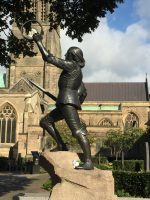 I carry in my head the vivid but fictional villainy of Shakespeare’s Richard. That image vies with the version I created for myself in fictions of a Richard and Khan redeemed not only by love but by the desire to be worthy of such love.
I carry in my head the vivid but fictional villainy of Shakespeare’s Richard. That image vies with the version I created for myself in fictions of a Richard and Khan redeemed not only by love but by the desire to be worthy of such love.
With these few days in Leicester, I also carry now the more balanced image of Richard: a man of his time. He was for many years a loyal brother, a courageous warrior, and a wise administrator who may have been responsible (through direct deed or indirectly through his authority over those who committed it) of the deaths of his nephews; or may have been made the scapegoat by those who had as much to gain from their deaths but less obvious opportunity to ensure them.
Unless further miracles of history occur to tell us, we’re left to choose the Richard we prefer. Our preference is probably determined by our own natures.
I prefer to believe in a man who tried to be fair and loyal but was compromised by circumstance: at worst, his own ambition, at best, a too-rigid belief in the rule of succession within the context that Edward’s children may well have been illegitimate and that made him the rightful heir, come hell or high water.
As Hamlet says of his father: “He was a man, take him for all in all, I shall not look upon his like again.”
Tim and I were guests of the Belmont Hotel and the King Richard III Visitor Centre in Leicester.
Whether or not you’re a Ricardian, you might enjoy my most recent books: Ravenfall, a paranormal thriller and gay romance set in contemporary London, and Near Miss, a short lesbian love story with yarnbombing, set in Melbourne. If het love/adventure stories are more your thing, check out my spy series, Secret Agents, Secret Lives.
September 14, 2017
The Lady Novelist pays her respects to King Richard III (part 1)
 My relationship with Richard III is a bit rambling and has a few strange turns.
My relationship with Richard III is a bit rambling and has a few strange turns.
Like most people, what I knew of Richard Plantagenet, Duke of Gloucester, boiled down to one simple story: he was a wicked, hunchbacked man who stole the throne and murdered his innocent nephews, before being cut down in battle while calling out for a horse.
Shakespeare’s play – a fiction written for a Tudor audience and heavily influenced by histories written by Tudor accounts – obviously in turn influenced centuries of popular opinion on this game loser of the Wars of the Roses.
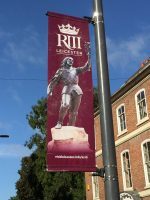 These days, I’m a much keener advocate of King Richard III as a misunderstood monarch. Books like The Maligned King have sewn enough doubt about his complicity in the boys’ disappearance and made me a Ricardian!
These days, I’m a much keener advocate of King Richard III as a misunderstood monarch. Books like The Maligned King have sewn enough doubt about his complicity in the boys’ disappearance and made me a Ricardian!
My road to becoming one actually began with Shakespeare, though, and Martin Freeman’s brilliant 2014 turn as the cruel and broken man. (More recently, Kate Mulvany’s portrayal was breathtaking too).
Hot on the heels of my second viewing of theTrafalgar Theatre production, my friend, fellow writer and co-conspirator, Wendy Fries, dared me to write a Richard III/Star Trek’s Khan fanfiction. After 30 seconds of denying such a thing was possible, I wrote the first of what turned out to be 14 stories of time travel, reincarnation, epic love and redemption.
I turned Shakespeare’s (and Freeman’s) mad, bad Richard into a whole new character – and my curiosity about the real Richard was revived. Not long after I’d written the stories, Richard’s recently rediscovered bones were reinterred at Leicester Cathedral. The pathos of the moment, combined my unexpected emotional investment in both the fictional and the real King, spurred me onto further reading. I read Jospehine Tey’s The Daughter of Time and then, hungry for facts, Annette Carson’s The Maligned King.
All of which brings me to Leicester, and on the trail of the history of King Richard III, who was surely no saint, but who wasn’t a black-hearted villain either.
The Bosworth Battlefield
 My first day in Leicester took us to the Bosworth Battlefield Heritage Centre. Between intermittent bursts of rain and sunshine, we were guided through the exhibition in the old farmhouse by the centre’s curator, Richard Knox.
My first day in Leicester took us to the Bosworth Battlefield Heritage Centre. Between intermittent bursts of rain and sunshine, we were guided through the exhibition in the old farmhouse by the centre’s curator, Richard Knox.
The actual location of the battlefield wasn’t certain until relatively recently, when investigation located both the marsh in which Richard III’s horse got bogged and a wealth of medieval cannon balls. The Centre is located on what was the King’s encampment. From the nearby hill, a frame surmounted by Richard’s and Henry Tudor’s standards looks down on the valley where Richard met his end.
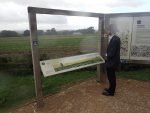 There’s a trick of imagination I indulge when visiting historical sites. I close my eyes and try to place myself across time, in the shoes of whoever once stood here. I have rested on the stones at the base of the Egyptian pyramids where workers once rested. I have placed my hands on Roman walls that were built by hands long gone to dust.
There’s a trick of imagination I indulge when visiting historical sites. I close my eyes and try to place myself across time, in the shoes of whoever once stood here. I have rested on the stones at the base of the Egyptian pyramids where workers once rested. I have placed my hands on Roman walls that were built by hands long gone to dust.
This day I stood on the earth that those long-gone medieval once stood on; suffered on; died on.
Here a man with a twisted spine – recently bereaved of both son and wife, an administrator with a concern for justice who was overhung with an appalling mistrust over the fate of his disinherited and vanished nephews – decided to live or die as a king of England.
Had he killed Henry instead of Henry’s standard bearer, the fate of English history may have been different.
 The Bosworth Battlefield Heritage Centre takes no sides in the debate about Richard’s character. As Knox says during our tour, the job of the centre is to present the facts of the battle as far as they can be known. This includes presentations of the events leading to the battle, the kinds of weapons and armour used, the key events during the battle as understood from contemporaenous reports, and the aftermath.
The Bosworth Battlefield Heritage Centre takes no sides in the debate about Richard’s character. As Knox says during our tour, the job of the centre is to present the facts of the battle as far as they can be known. This includes presentations of the events leading to the battle, the kinds of weapons and armour used, the key events during the battle as understood from contemporaenous reports, and the aftermath.
 The centre also presents material from the various archaelogical researches that went into locating the actual battlefield. Among the items on display is a boar pin, which would have been worn by one of Richard’s household, who rallied to him in the fatal final moments of the battle. Where it was found, the historians surmise, is where he fell, fighting
The centre also presents material from the various archaelogical researches that went into locating the actual battlefield. Among the items on display is a boar pin, which would have been worn by one of Richard’s household, who rallied to him in the fatal final moments of the battle. Where it was found, the historians surmise, is where he fell, fighting
 These final hours of Richard’s short life and two-year reign are covered at the centre with objective thoroughness. If you’re interested in medieval history, whether or not you’re a Ricardian, it’s worth the considerabal trek out to see this thoughtful and intelligently presented battlefield site.
These final hours of Richard’s short life and two-year reign are covered at the centre with objective thoroughness. If you’re interested in medieval history, whether or not you’re a Ricardian, it’s worth the considerabal trek out to see this thoughtful and intelligently presented battlefield site.
Next I’ll be writing about the discovery of Richard’s body under a Leicester car park and his reinterment at the cathedral.
Tim and I were guests of the Belmont Hotel and the Bosworth Battlefield Heritage Centre in Leicester.
September 12, 2017
Publishing Roundup: lesbian romance, gay vampires, and Sherlock Holmes in Melbourne
The last few months have seen a few publishing milestones for me, so here’s a bit of a roundup before I resume my travel reports from the UK.
Gay Vampires: Ravenfall
 While walking around on a self-guided tour of Roman London, I stumbled across this fantastic view of the Shard and London Bridge Hospital. The Hospital features in the bloody climax of my London-set paranormal thriller, Ravenfall.
While walking around on a self-guided tour of Roman London, I stumbled across this fantastic view of the Shard and London Bridge Hospital. The Hospital features in the bloody climax of my London-set paranormal thriller, Ravenfall.
The book is also a gay romance, with vampire James Sharpe trying to reclaim his humanity, with the help and love of the very human artist, Gabriel Dare. They might do well with that, provided they survive the plot in which James’s sire is involved.
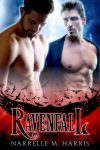 Recent guest posts about Ravenfall:
Recent guest posts about Ravenfall:
Release day: Ravenfall – read an extract of the novel.
Ravenfall and the romantic vampire – a post about locations, inspiration and the quest to be human.
Tell us Your Backstory – the story of how James became Scottish for the book.
Buy Ravenfall
Ravenfall (Clan Destine Press)
Ravenfall
 (Amazon.com)
(Amazon.com)Ravenfall (Amazon UK)
Ravenfall (Barnes and Noble)
Ravenfall (Angus and Robertson)
Ravenfall (Book Depository)
Ravenfall (Booktopia)
Sherlock Holmes in Australia
 I’ve written Holmes and Watson in Australia as a canon-era love story in The Adventure of the Colonial Boy – but I also write more traditional stories of them as epic best friends. I have stories in two sepearate anthologies, both set in Australia!
I’ve written Holmes and Watson in Australia as a canon-era love story in The Adventure of the Colonial Boy – but I also write more traditional stories of them as epic best friends. I have stories in two sepearate anthologies, both set in Australia!
Sherlock Holmes: The Australian Casebook is coming out in November. My story, The Mystery of the Miner’s Wife, is set in Ballarat.
Baker Street Irregulars 2: The Game’s Afoot is due out in April 2018. It’s full of alternative universe interpretations of Sherlock Holmes. In my story, The Problem of the Three Journals, Holmes and Watson are contemporary Melburnian hipsters, running their cafe, The Sign of Four, and solving mysteries. The book is currently available for preorder:
Baker Street Irregulars 2: The Game is Afoot (Amazon.com)
Baker Street irregulars 2: The Gameis Afoot (Amazon UK)

Lesbian romance: Near Miss
 Near Miss, set in Melbourne, is the story of a rock chick and a cool hairdresser who keep not quite meeting until a yarnbombing event intervenes. It came out in August.
Near Miss, set in Melbourne, is the story of a rock chick and a cool hairdresser who keep not quite meeting until a yarnbombing event intervenes. It came out in August.
I wrote about the story and yarnbombing for Women and Words: Creative Rebellion and Joyful Defiance.
You can get Near Miss at:
Near Miss
 (Amazon)
(Amazon)Near Miss (Amazon UK)
Near Miss (Amazon Australia)
Near Miss (Kobo)
Near Miss (Angus and Robertson)
Near Miss (iBooks)
September 11, 2017
The Lady Novelist explores Sherlock Holmes’s London (Part 2)
 I hit the ground running on my first day in London, what with the Britmovietours Sherlock Holmes walk and the much less strenuous delights of staying in the Langham Hotel.
I hit the ground running on my first day in London, what with the Britmovietours Sherlock Holmes walk and the much less strenuous delights of staying in the Langham Hotel.
My second day in London, “that great cesspool into which all the loungers and idlers of the Empire are irresistibly drained” was spent even more energetically.
“I am the most incurably lazy devil that ever stood in shoe leather—that is, when the fit is on me, for I can be spry enough at times” ~ Sherlock Holmes, A Study in Scarlet.
I hesitate to say I was spry at all, but I was far from lazy.
Madame Tussaud’s
I’d always assumed the famous waxworks museum would be cheesy though slickly presented. I wasn’t especially tempted to visit, although I’ve been fascinated to read about the history of waxwork models and their role in studying anatomy through the publications of the now-defunct Morbid Anatomy Museum.
 A visit to Madame Tussaud’s was on the cards, though, because of its Sherlock Holmes Experience theatrical event. And also because it houses a couple of Sherlock Holmeses!
A visit to Madame Tussaud’s was on the cards, though, because of its Sherlock Holmes Experience theatrical event. And also because it houses a couple of Sherlock Holmeses!
The waxworks is every bit as cheesy as I’d expected, and also very slick – and a huge amount of fun. It’s a curious collision of the historical and the new, because Madame Tussaud originally made her waxworks of famous figures in the late 18th century. Here we are in the 21st with essentially the same technology and the same purpose – but now we can take selfies with our celebrity substitutes. Knowing they’re wax replicas doesn’t diminish the fun. In fact, if you’re a Doctor Who fan, you can imagine them all as Aurons about to come to life and the fun just doubles.
 Naturally I had photos taken with a few of my favourite historical and theatrical faves: William Shakespeare, Freddy Mercury, Helen Mirren and Benedict Cumberbatch.
Naturally I had photos taken with a few of my favourite historical and theatrical faves: William Shakespeare, Freddy Mercury, Helen Mirren and Benedict Cumberbatch.
It’s a labryinth inside, but eventually we came across the entry to the Sherlock Holmes Experience. Robert Downey Junior’s Sherlock stood sentry in the chamber, designed to look like a Victorian London Street.
 The Experience is a bit of a mixed bag – the Baker Street set is good fun, and Mrs Hudson’s greeting and explanation of the puzzle is full of pizzazz. It’s fun to be sent through doors and find yourself at the docks, the morgue and other locales. The final part of the story gallops a bit quickly to a close and feels like it runs out of puff. But never mind: the crypt in which you find yourself is full of headstones with fabulously silly puns which you’ll get if you know your Conan Doyle canon.
The Experience is a bit of a mixed bag – the Baker Street set is good fun, and Mrs Hudson’s greeting and explanation of the puzzle is full of pizzazz. It’s fun to be sent through doors and find yourself at the docks, the morgue and other locales. The final part of the story gallops a bit quickly to a close and feels like it runs out of puff. But never mind: the crypt in which you find yourself is full of headstones with fabulously silly puns which you’ll get if you know your Conan Doyle canon.
Madame Tussaud’s London
The Sherlock Holmes Experience.
London Walks: Sherlock Holmes’s London
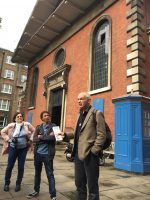 Not content with punishing the shoe leather as mentioned, Tim and I went on to join the regular Friday afternoon Sherlock Holmes’s London tour run by London Walks.
Not content with punishing the shoe leather as mentioned, Tim and I went on to join the regular Friday afternoon Sherlock Holmes’s London tour run by London Walks.
Our guide was Richard (the Fourth of his name at the company) who was led us on our two-hour tour with its focus on Arthur Conan Doyle’s life and inspirations in London as well as locations from the 60 Sherlock Holmes stories he gave us.
Richard not only knows his ACD and Sherlock Holmes stuff, he speaks with warmth and wit. On the rare occasions this walk overlapped with the Britmovietour’s, Richard provided different anecdotes, so nothing is lost by going on both walks.
If you’re more a fan of the original stories than the various film versions, this is probably the walk for you, as it winds around places where Conan Doyle lived or visited as well as locations he used or was inspired by in creating his iconic characters.
In any case, for £10 it’s a great look at London and Sherlock Holmes, set at a pace that even Mycroft might easily manage, let alone Sherlock on a lazy day.
Sherlock Holmes’s London walking tour
I have no secrets from Sherlock Holmes: Tim Richards and I are being hosted on this trip by VisitBritain.
While you’re in a Sherlockian mood, you might like to read my Holmes ♥ Watson novel The Adventure of the Colonial Boy, or a traditional Holmes + Watson short story.
Speaking of which, my Holmes + Watson story The Problem of the Three Journals, an alternative universe tale of Holmes and Watson as a pair of Melbourne hipsters who run a cafe and solve mysteries, will appear in Baker Street Irregulars 2: The Game is Afoot in 2018. You can pre-order your copy now!
Baker Street Irregulars 2: The Game is Afoot (Amazon.com)
Baker Street irregulars 2: The Gameis Afoot (Amazon UK)[image error]
September 7, 2017
The Lady Novelist explores Sherlock Holmes’s London (Part 1)
 I am off on one of my semi-regular jaunts to the UK for the purposes of research and fun (which are usually the same thing).
I am off on one of my semi-regular jaunts to the UK for the purposes of research and fun (which are usually the same thing).
2017 marks 125 years since Arthur Conan Doyle’s collection The Adventures of Sherlock Holmes was published (1892) and 130 since A Study In Scarlet first saw print.
In fact, VisitBritain is all about 2017 as ‘the year of the literary hero‘, referencing anniversaries related to Jane Austen, Enid Blighton, the Harry Potter books, the death of war poet Edward Thomas and more.
My own special interest in Sherlock Holmes – in both queer and bromance interpretations – is leading me to Holmesian London over a the next three days. I aim to incorporate a few of these details into both Victorian and modern Holmes stories I’m working on.
The Langham
 The Langham Hotel on Portland Place (off Regent Street) has more than one connection with The Great Detective.
The Langham Hotel on Portland Place (off Regent Street) has more than one connection with The Great Detective.
Famously, it was at the Langham’s dining room in 1889 that Oscar Wilde and Arthur Conan Doyle (not yet ‘Sir Arthur’) met with the publisherJoseph Stoddart. They were commissioned to write A Picture of Dorian Grey and The Sign of Four respectively (and even gave each other cameos in the resulting books).
Doyle went on to assign the Langham as the hotel of choice for three of his characters: The King of Bohemia (A Scandal in Bohemia), Mary Morstan’s lost father (The Sign of Four), and the former tearaway and poet Mr Phillip Green (The Disappearance of Lady Frances Carfax).
The Langham remains every bit as charming and elegant as its literary history suggests. The various restaurants and bars are lovely spaces to visit the hotel and raise a glass to Conan Doyle and his creations.
Britmovietours:Sherlock Holmes Walking Tour of London
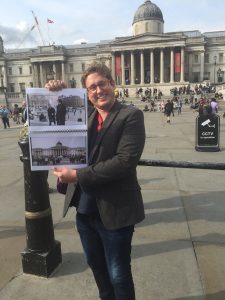 The Sherlock Holmes Walking Tour of London, conducted by Chris Taylor of Britmovietours, is marvellously inclusive of Conan Doyle’s original stories, several films, the recent BBC and U.S. television adaptations, and even a glimpse of my favourite, the show that brought me to Holmes, the Jeremy Brett Granada series from the 90s.
The Sherlock Holmes Walking Tour of London, conducted by Chris Taylor of Britmovietours, is marvellously inclusive of Conan Doyle’s original stories, several films, the recent BBC and U.S. television adaptations, and even a glimpse of my favourite, the show that brought me to Holmes, the Jeremy Brett Granada series from the 90s.
Chris is enthusiastic and, even better, knowledgeable. I know a lot about the world of Holmes, having researched and read the stories multiple times as prep for writing The Adventure of the Colonial Boy and some upcoming short Holmes + Watson stories, but he was still able to surprise me with some tidbits about canon and BBC Sherlock.
The walk starts on Piccadilly Circus at The Criterion Bar, where John Watson’s old friend Stamford famously noted that he knew someone who might want to share ‘comfortable rooms at a reasonable price’ with him.
 A meandering two hour wander took us past filming locations, over Waterloo Bridge and past some of Conan Doyle’s real-life haunts and inspirations (including the former Northumberland Hotel, now the Sherlock Holmes Pub) to fetch up at Somerset House. The latter is no longer the repository of records of Births, Deaths and Marriages but it stands in as a less reputable location in one Holmesian film.
A meandering two hour wander took us past filming locations, over Waterloo Bridge and past some of Conan Doyle’s real-life haunts and inspirations (including the former Northumberland Hotel, now the Sherlock Holmes Pub) to fetch up at Somerset House. The latter is no longer the repository of records of Births, Deaths and Marriages but it stands in as a less reputable location in one Holmesian film.
The walk is £12 for adults: very reasonable given Chris’s energy and knowledge shared over two hours. If you want to know more, visit and book here.
I am about to topple over from lack of sleep (I touched down this morning, and headed out with half a globe and five hours sleep under my belt – GO ME!).
Tomorrow I’ll visit an exhibition and take another walk – so more reports from the field (hopefully more useful than Dr Watson’s during The Solitary Cyclist) are coming!
I have no secrets from Sherlock Holmes: Tim Richards and I are being hosted on this trip by VisitBritain.
Pssst. While you’re reading, please consider reading my new short story Near Miss, and my M/M paranormal thriller, Ravenfall, which is set in London!
August 31, 2017
Release day: Ravenfall
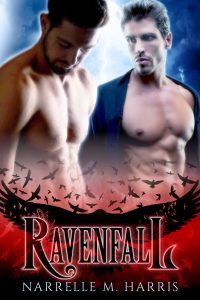 It’s 1st September, and a happy release day to my latest (and eighth) book, Ravenfall, published by Clan Destine Press.
It’s 1st September, and a happy release day to my latest (and eighth) book, Ravenfall, published by Clan Destine Press.
If you have pre-ordered the paperback, today’s the day your retailer will send it to you on black feathery wings!
Set in contemporary London, Ravenfall is the story of James Sharpe, a vampire who wonders if it’s possible to fallin love, since he doesn’t even know if he has a soul, and Gabriel Dare, an artist who’s wondered all his life if he was mad but he’s pretty sure about one thing – James Sharpe is the best thing in his life. Can he convince James of the same?
They’ll find those answers together, provided they survive all the other monsters who have schemes of their own. People are dying, nobody is safe, and even the undead can die. James and Gabriel will have to risk it all in order to be together for as much of forever as they can manage.
An extract from Ravenfall:
Curious, Gabriel stabbed the tip of the silver knife into the jar of garlic, and placed it in the dish of vampire blood. The blood fizzed, coagulated and gave off a terrible stink.
‘Better toss the silverware out too, then,’ he said.
James, who had pushed well back from the table, shook his head. ‘Keep it in your room.’
Gabriel was inclined to argue the point, but James was staring at the dish of blackened vampire blood in fascinated horror.
‘We don’t have to do this now,’ Gabriel offered gently.
‘We have to find out, don’t we? Apart from anything else, you need protection. You may one day need it from me.’
‘Don’t be ridiculous.’
‘I’m not being ridiculous. You don’t… you don’t know what I… You don’t know.’
Gabriel reached for James’s shoulder, echoing James’s earlier solace.
‘I’m an excellent judge of character, remember? If you can’t trust yourself, trust me. I lived with a father who did his best to grind me into the dirt to get back at my mother; a man who medicated me from the ages of eight to twelve and packed me off to psychiatrists and institutions rather than try to listen, let alone understand. I lived on the streets, and I’ve fought for my independence my whole life. I know what people who want to hurt me look and sound like. You’re not like them. You don’t want to hurt me.’
‘No. I don’t.’
Gabriel’s leaned across the table to kiss James’s mouth. Their lips met, soft and chaste and sweet. James’s skin warmed under Gabriel’s tender touch. He didn’t kiss back, exactly, but with his head tilted up, his whole stance softened, relaxed, held still, and he received the kiss like a benediction. When Gabriel drew away, James’s eyes were closed.
‘James.’
James’s blue eyes opened, and they were full of longing and sorrow and fear. ‘I don’t want to hurt you. That doesn’t mean I won’t without meaning to. It’s happened before. When I first woke like this. A vampire. I didnae know what I was yet. But I was so thirsty and… I did monstrous things, Gabriel.’
‘But you’re not a monster. Trust me on this.’
‘Eight hours ago, you didn’t know that vampires could exist. Now you’re telling the one you live with that you trust him.’
‘Yes.’
‘With your life.’
‘Yes.’
‘You’re daft. But please. Even if you can trust my intent, you can’t trust the thirst. Promise me you’ll defend yourself if I… if I forget myself again.’
Mark Ravenfall To Read on Goodreads now!
Buy Ravenfall in paperback!
Ravenfall (Clan Destine Press)
Ravenfall
 (Amazon.com)
(Amazon.com)Ravenfall (Amazon UK)
Ravenfall (Barnes and Noble)
Ravenfall (Angus and Robertson)
Ravenfall (Book Depository)
Ravenfall (Booktopia)
The ebook is coming in a month.



